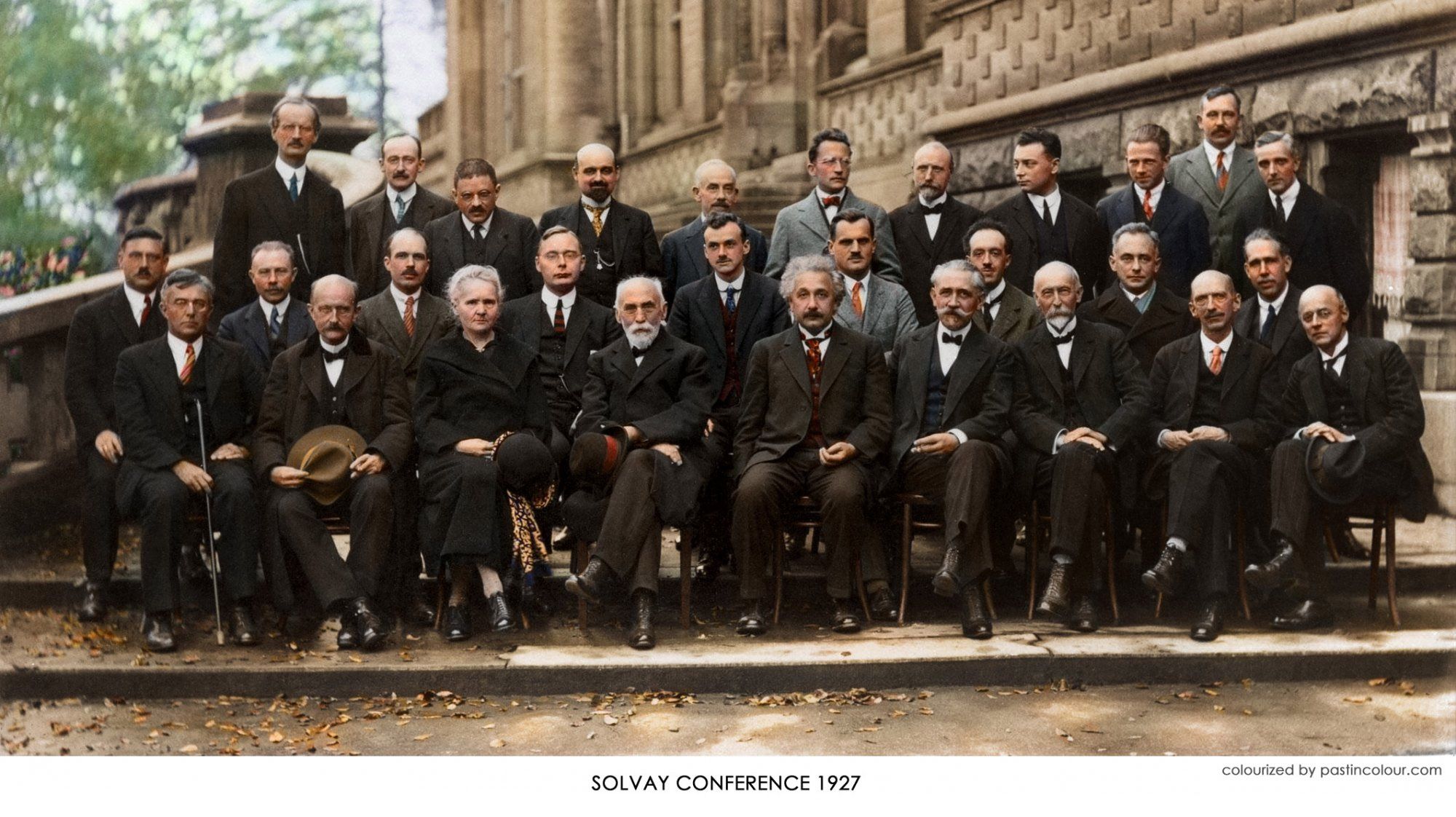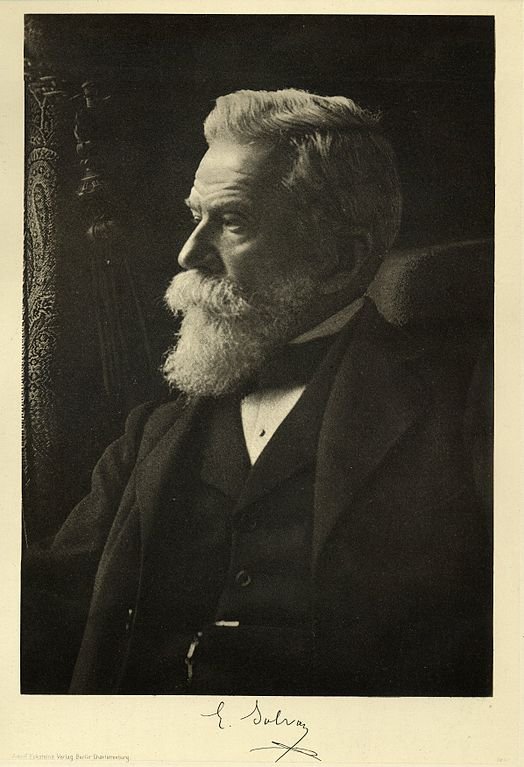#0 IQ overload: the story of one photo | Przeciążenie IQ: historia jednego zdjęcia

- Auguste Piccard
- Émile Henriot
- Paul Ehrenfest
- Édouard Herzen
- Théophile de Donder
- Erwin Schrödinger
- Jules-Émile Verschaffelt
- Wolfgang Pauli
- Werner Heisenberg
- Ralph H. Fowler
- Léon Brillouin
- Peter Debye
- Martin Knudsen
- William Lawrence Bragg
- Hendrik Anthony Kramers
- Paul Dirac
- Arthur Compton
- Louis de Broglie
- Max Born
- Niels Bohr
- Irving Langmuir
- Max Planck
- Maria Skłodowska-Curie
- Hendrik Lorentz
- Albert Einstein
- Paul Langevin
- Charles-Eugène Guye
- Charles Thomson Rees Wilson
- Owen Richardson
Introduction
Wprowadzenie
The image below is very often called a photo that contains the highest concentration of outstanding 20th century scientists. It is hard to disagree, as 17 of them have received the Nobel Prize. The names of these geniuses are in each of the textbooks for physics, both in those imparting basic knowledge and those more advanced. However, not all participants of the 5th Solvay Conference are well known. In my opinion, each of these people carries an interesting story and can become an inspiration to others. So I decided to create a series of articles in which I will try to present the story of every genius in this photo. But I will start with the history of the conference itself...

Zdjęcie przedstawione niżej jest bardzo często nazywane zdjęciem, które zawiera najwyższe stężenie wybitnych naukowców XX wieku. Ciężko się z tym nie zgodzić, bowiem aż 17 z nich otrzymało nagrodę Nobla. Nazwiska tych geniuszy znajdują się w każdym z podręczników do fizyki, zarówno w tych przekazujących podstawową wiedzę jak i tych bardziej zaawansowanych. Jednak nie wszyscy uczestnicy 5 Kongresu Solvaya są powszechnie znani. Według mnie każda z tych osób niesie ze sobą ciekawą historię i może stać się inspiracją dla innych. Postanowiłem więc stworzyć serię artykułów, w której będę starał się przedstawić historię każdego geniusza z tego zdjęcia. Zacznę jednak od historii samego kongresu...

Ernest Solvay
Electrons and Photons
Elektrony i Fotony
It was 1927. Quantum mechanics was still young, and discussions about it continued. Interpretations of quantum mechanics were different, and the scientists debated which is correct. In 1927 probably the most famous scientific conference took place - 5th Solvay Conference. The conference's main theme was electrons and photons. Although photons had been known for some time, the concept of photon began to be widely used only after Conference. Scientists were discussing the micro world principles - quantum mechanics. The leaders of the opposite camps were undoubtedly Niels Bohr (supporter of the Copenhagen Interpretation) and Albert Einstein (opponent).
It is also worth to introduce the genesis of the Solvay Conferences, the most famous of which was the fifth. Solovaya Conferences, are a regular meeting of eminent physicists or chemists. The first conference took place in 1911 and its subject was "The theory of radiation and quanta". The initiator of the Conference was Belgian passionate scientist Ernest Solvay, who, after developing the method for the manufacturing of soda ash, with his brother, founded Solvay & Cie. His industrial activities provided him with a fortune to help him organize and fund this scientific conference. Each conference is divided into half-day sessions that begin with the presentation of one or two reports on the latest topics and the rest of the time is devoted to discussions between scientists. This is characteristic of Solvay Conferences because most of the conferences focus on presentations instead of discussions. Conferences are held to this day, every three years.
To date, 26 congresses have taken place. This number, however, will soon change, as this year's 27th Solvay Conference is coming. The subject of the conference will be "The physics of living matter: Space, time and information in biology". Conferences were very important in the development of quantum mechanics and other contemporary problems of physics and chemistry. What do you think will be the topics of future Congresses?

Był rok 1927. Mechanika kwantowa była wciąż młoda, a dyskusje na jej temat trwały. Interpretacje mechaniki kwantowej były różne, a a naukowcy debatowali, która jest słuszna. W owym roku 1927 miała również miejsce prawdopodobnie najbardziej znana konferencja naukowa - 5 Kongres Solvaya. Hasłem przewodnim konferencji były elektrony i fotony. Mimo tego, że fotony byłby znane już jakiś czas, samo pojęcie fotonu zaczęło być szeroko używane dopiero po Kongresie. Naukowcy dyskutowali o mikroświecie, a liderami przeciwnych obozów byli niewątpliwie Niels Bohr (zwolennik Interpretacji kopenhaskiej) oraz Albert Einstein (przeciwnik).
Warto przedstawić również genezę Kongresów Solvaya, ten najsławniejszy był piąty, ale przed nim były inne a same konferencje odbywają się do dzisiejszego dnia (zazwyczaj co trzy lata). Kongresy Solovaya to cykliczne spotkania wybitnych fizyków lub chemików. Pierwsza konferencja miała miejsce w 1911 roku a jej hasłem przewodnik było "teoria promieniowania i kwanty". Inicjatorem Kongresu był belgijski pasjonat nauki Ernest Solvay, który po opracowaniu metody otrzymywania sodu wraz z bratem założył firmę Solvay & Cie. Jego działalność przemysłowa zapewniła mu majątek, dzięki któremu mógł zorganizować i ufundować konferencję naukową. Każda konferencja jest dzielona na sesje trwające pół dnia, które zaczynają się od przedstawienie jednego bądź dwóch sprawozdań z najnowszych tematów, a reszta czasu jest przeznaczana na dyskusje pomiędzy naukowcami. Jest to charakterystyczne dla Kongresów Solvaya, ponieważ większość konferencji naukowych skupia się na prezentacjach zamiast na dyskusjach.
Do dzisiaj odbyło się 26 Kongresów. Liczba ta jednak szybko się zmieni, ponieważ już w tym roku odbędzie się 27 konferencja, na której będą trwały dyskusje o fizyce materii żywej. Kongresy były bardzo ważne w rozwoju mechaniki kwantowej oraz innych współczesnych problemów fizyki i chemii. Jak myślicie, jakie będą tematy przyszłych Kongresów?
Upvoted and Resteemed by xx-votesplus, the dropAhead curation team!
Do you want more earnings?
By doing things above you will give us more STEEM POWER (SP) to give you more earnings.
Keep up the good work!
Most recent post: It is official, WE are witnesses!
Interesting idea for series. I will be following! Biedronka!
Podoba mi się. Będę śledzić kolejne posty.
@jakipatryk got you a $8.68 @minnowbooster upgoat, nice! (Image: pixabay.com)
Want a boost? Click here to read more!
Ciekawe, śledzę i leci upvote :)
Congratulations! This post has been upvoted from the communal account, @minnowsupport, by jakipatryk from the Minnow Support Project. It's a witness project run by aggroed, ausbitbank, teamsteem, theprophet0, someguy123, neoxian, followbtcnews/crimsonclad, and netuoso. The goal is to help Steemit grow by supporting Minnows and creating a social network. Please find us in the Peace, Abundance, and Liberty Network (PALnet) Discord Channel. It's a completely public and open space to all members of the Steemit community who voluntarily choose to be there.
Patryk, skąd pomysły na takie artykuły?!?!!?
Zainteresowania :)